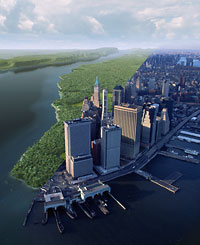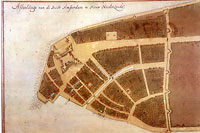The Canary in the Gold Mine
A New York Museum Envisions Manhattan in 1609
By Nicole Pasulka
Manhattan may not need yet another excuse to show off, but this year it certainly has one. To celebrate the 400th anniversary of Henry Hudson’s “discovery” and mapping of Mannahatta Island in September 1609, two exhibits at the Museum of the City of New York (MCNY) unearth records of the pristine Mannahatta Island’s transformation into Manhattan, New York. How did an island once so abundant with wildlife become one of the most intensely developed places on the planet?
Through computer mapping, landscape ecologist Dr. Eric Sanderson, of the Wildlife Conservation Society, created an ecological portrait of Mannahatta on September 12, 1609; a time when the island had, as he writes, “more ecological communities per acre than Yellowstone, more native plant species per acre than Yosemite, and more birds than the Great Smoky Mountains National Park.” This richness, along with easy access to the Atlantic Ocean and the Eastern Seaboard, helps to explain why the island has been, in turns, an industrial, commercial, financial, and cultural global center. The MCNY display and the book Mannahatta: A Natural History of New York City (Abrams) encourage 21st-century New Yorkers to learn from the sustainable lifestyle of Lenape tribes living on the island at the time and asks that contemporary residents attempt to integrate wildlife and environmental diversity into the urban environment.
But there’s another record of Manhattan’s evolution on display at the museum: written accounts of civil and criminal proceedings, dating from the Dutch arrival in what was first known as Fort Amsterdam. After nearly 400 years hanging around different court and city agencies—first Dutch, then British, now unquestionably American—some pages from these records have made their way into the museum show, and I want to see more where they came from.
Manhattan had more birds than the Great Smoky Mountains National Park.
My curiosity led me to a quiet basement corner of the Surrogate’s Court Building of New York County, where New York City’s archives are kept. At the Municipal Records Center, assistant commissioner Ken Cobb swung open the door of a six-foot-tall, elegantly ornamented safe to show me the six carefully conserved volumes of Dutch records acquired from the City Clerk’s office in the 1980s. Upon white-gloved inspection—by Cobb and fellow conservator Ellen Chin—the early records overflow with elegant and remarkably legible writing. Despite no knowledge of 17th-century colonial Dutch, we all three made out the word “extraordinary.”
Despite the obvious care taken in recording the ledgers and legal proceedings, most of the documents arrived here bound out-of-order and in some cases upside-down and the pages are browned, tattered and flaking away. Since acquiring the records, conservators have restored their integrity by floating the original leaves or folios in a slurry of pulp. In the slurry, a computer determined how much pulp each page needed, and the remaining water was sucked out, leaving the pages remarkably fortified. Though they’ve been beautifully restored, the documents are still fragile. “We don’t want them up for the full six months since the ink is faded already,” Cobb explained. The exhibit’s curators have instructions to swap pages and replace with reproductions or different originals after three months time.
On the lab’s wide table, Chin laid a booklet in its original binding, titled, “Minutes of the Common Council, 1690-1699.” The thick brown cover looked like a water-damaged paper bag, but according to Chin, the volume seems to be written on good quality paper that likely came from Europe. As for the rest of the six-volume archive, “we’ve decided to leave them unbound,” Cobb told me. “Then, when we loan pages out for exhibits like this one, we won’t have to loan the whole book.”
One of the pages on display at the museum describes the first arrival of Jews in the city in 1654. After looking at a transparency of the original document in Dutch, we found the corresponding page in the handwritten 19th-century translations. I later headed upstairs to the Municipal Archives Records Room where, next to a cabinet containing microfilm photos from the Department of Dock and Ferries and pictures of borough presidents, I was able to read the same page, translated, restored, reprinted by The Genealogical Publishing Co. in Baltimore. Here, a weathered piece of paper had, after nearly 400 years, become just another page in a bright orange, library-bound reference book stored in a municipal building of an island that, with no small amounts of bloodshed, adventure, development and destruction, has been transformed from ecological gem to urban gold mine.









